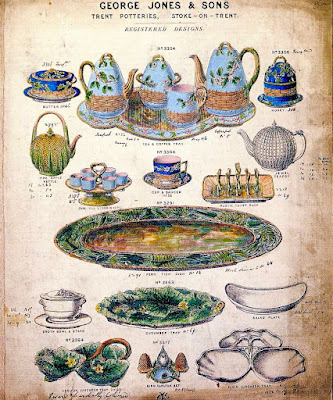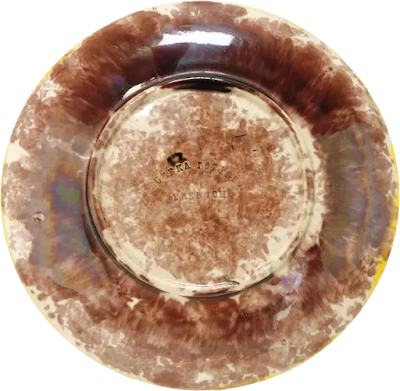There are many clues to identifying a piece of majolica in the absence of a mark.
Most easily is the advertising done by the potteries. Many potteries had sales catalogs they used to sell their products. Some participated in international exhibitions or advertised in the trade journals of their day. Here in this blog I have posted many examples of these catalog pages and trade ads. Forester, Lear, the Etruscan Works, Massier, Orchies, George Jones, Minton, Wedgwood, Arsenal, Desvres and others all have graced the posts of this blog. A look at some of the individual blog posts I’ve made here can help instantly identify an unmarked piece.
Another way is by the treatment on the reverse of the piece. Potteries had a relatively consistent means of glazing the reverse of their wares. This is my no means fool proof because there are exceptions to every pottery but on a whole there are some glaze treatments that are more common from some potteries than others. If one were to examine several similar treatments of the reverse glaze one can pretty accurately get an idea about who made what.
Let’s take the work of Thomas Forester for example. Forester was one of the most prodigious potters of Victorian pottery in Great Britain yet few of his wares were ever marked. However, they treated the reverse of their pieces in several similar ways. The most common of these treatments was with a distinctive mottling technique done only by them. It is a muddy green and brown mottle. either plain or with a yellow center on flatware. An example is shown below.
This same glaze treatment is frequently also used on the obverse of pieces. Another treatment they used was with a yellow wash with a decorator’s number or a combination of the green and brown mottle or sponged brown glaze with a yellow or white center on their flatware, generally with a decorator’s identification mark.
Minton almost always marked their pieces as did Wedgwood but George Jones did not. Minton preferred a green, turquoise or white underside glaze on some pieces and blue and brown on their Palissy pieces. Large pieces are sometimes unglazed. Wedgwood used white sometimes plain, sometimes with a green and brown mottle or blue and brown mottle though they frequently varied. They also used an ivory glaze splashed with brown on some flatware.
Both Jones and Minton did exceptional glaze work with little glaze running. Wedgwood is usually exceptional in their glazing too but they are more likely to be less consistent with their work. The three are known for their exceptional work that makes them stand out among the run of the mill production.
Jones generally used a distinctive mottling on the underside they referred to as “snakeskin.” There is usually a “thumbprint” on the underside with a pattern number. Hollowware pieces, especially pieces with a small foot such as jugs often did not have the snakeskin mottling but instead were glazed in a solid color such as turquoise or pink, but there is usually a pattern number present. I have written about Minton, Wedgwood and George Jones identification before so you can refer to those posts for more detail.
Adams & Bromley almost never marked their wares but consistently used either a solid yellow glaze on the complete underside of their pieces or a sponged brown glaze.
Fielding, Lear, Brown-Westhead & Moore and Wardle most frequently used plain white glazes on the bases of their pieces and the potteries’ wares are often confused with each other. Sometimes they are marked and sometimes not, Occasionally they will have an English Registration mark. Recognizing their patterns are the easiest way of differentiating them. Refer to the posts on those potteries for patterns.
Shorter & Boulton preferred a gray wash on the underside of their pieces. Copeland is usually white and most often marked. Brownfield is only occasionally marked but they used distinctive buff colored clays with a clear glaze which will be recognizable with experience. The same is true for George Skey. They also both frequently used a similar color palette for many pieces. Refer to the posts on Brownfield and Skey for details.
Holdcroft often marked their wares but they also preferred a distinctive dull green underside glaze which makes identification easy. They also used a recognizable gray and brown mottle and occasionally a distinctive brown and green mottle
Unfortunately there were dozens of small potteries that made majolica throughout Great Britain that never marked their wares nor did they register their designs through the English Registration system so their output remain unknown. Some of these potteries are:
- Hall & Miller
- Thomas Heath
- William Hines
- John Kent & Son
- William Kirby & Co.
- Lincoln Pottery
- J. Dunlop Mitchell & Co.
- Mountford & Thomas
- Oakes, Clare & Chadwick
- Thomas Poole
- Pugh & Glover
- Robinson & Chapman
- Rosslyn Pottery
- Snow & Littler
- Hugh Sutherland
- Wagstaff & Brunt
There are many, many more. A list of some of these can be found in Victoria Bergesen’s book Majolica. Some were only in business for a short time so their anonymity is understandable but attribution on their output remains virtually impossible and frustrating.
Other potteries in this blog that feature identifying information include Victoria Pottery, Joseph Roth, Wasmuël, Belfield, Maw, Salopian Pottery, Fives-Lille, James Carr, Royal Dux and Onnaing. See their entries for assistance in patterns and identification.
French wares are usually marked but not always and there is no real consistency regarding the base treatments among those that are not marked. These can be vexing and require experience in recognizing predominant glaze combinations. Most frequently the underside will be the predominant color on the piece, especially in hollowware. They also often used a red lining on the inside of their hollowware jugs which you do not see outside of France and Brussels. Fortunately there are catalogs from the companies that have survived and numerous print publications with identity guides.
Thomas Sergent used a very distinctive clay body and color pallete which assists in identifying his unmarked pieces,
Another problematic issue with French majolica is that many patterns have been reissued into the 20th and 21st century so understanding the contemporary markings and glazes are crucial for differentiating Victorian pieces from contemporary ones.
Menton, Massier and Théodore Deck’s work are almost always marked.
In addition to a contemporary catalog of their majolica, Etruscan Majolica was always glazed on the reverse in one of four combinations. Most pieces were marked but some of the later pieces were not. They also used a pastel color palette that becomes instantly recognizable on sight. Refer to my post on Identifying True Etruscan Majolica for detail on identifying these.
Of all the potteries who made unmarked majolica those in central Europe these potteries are the most difficult to identify. Some potteries like Gerbing & Stephans, Schütz, Bernard Bloch, Zsolnay, Schiller, Brothers Urbach, Julius Geiner & Sohn, Fischer and Strnact marked their wares pretty consistently while many smaller potteries did not. Most of the records of these companies were lost during the world wars that plagued this area during the 20th century so we cannot identify their pottery until marked examples surface. One thing that many potteries in this area had in common was the use of impressed catalog numbers on the base. Unglazed bases on items like smoke sets are also common.
One identifying feature that you should NOT use, unless you know how to read it, is the English Registration mark. I have instructions for reading this mark here, but you often find dealers confusing the English Registration mark for a George Jones or Minton mark, which is incorrect. Understanding the Registration mark requires additional references not yet available online.
Another mark frequently mistaken for a pottery’s mark is the decorator’s mark. Most potteries used decorators who were paid by the number of pieces they decorated. To distinguish their work they would apply a brushed, written or stamped mark on the underside of the pieces they painted. They are marks made entirely for inside company production use and have no significance for pottery identification. A mark like this can be seen on the green Holdcroft plate shown above. Other potteries used impressed numbers and/or letters also for inside company use. Many of these are irrelevant to the contemporary collector.
Solid green majolica, unless marked, is usually impossible to identify because these patterns were copied extensively throughout Europe by numerous potteries. Some patterns are consistently produced by certain potteries but unfortunately these too were copied so identification cannot be authenticated without a mark.
There really is a lot of information both on this blog and other online sources that will help you identify the makers of antique majolica. With a little bit of research it will become easy to narrow down, if not identify many unmarked pieces either by their advertising, pattern, glazes or underside glaze. Be forewarned though, that copying and exceptions are rampant when identifying majolica. There are exceptions to every rule.





















